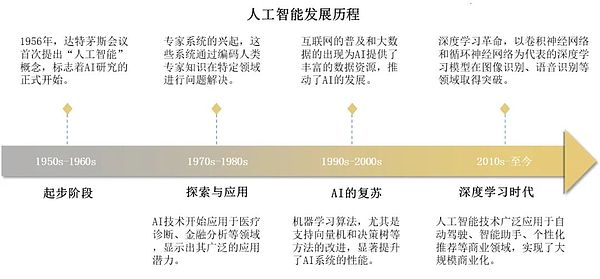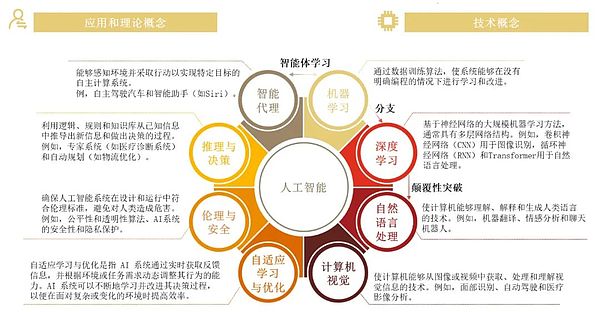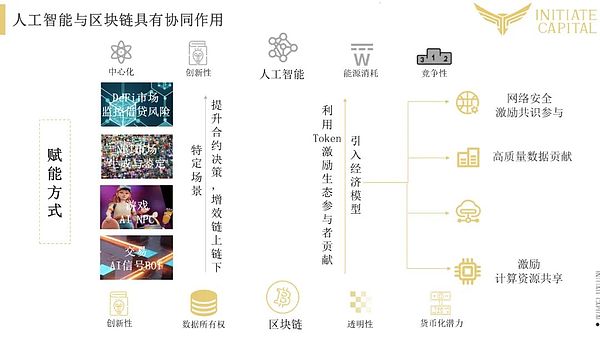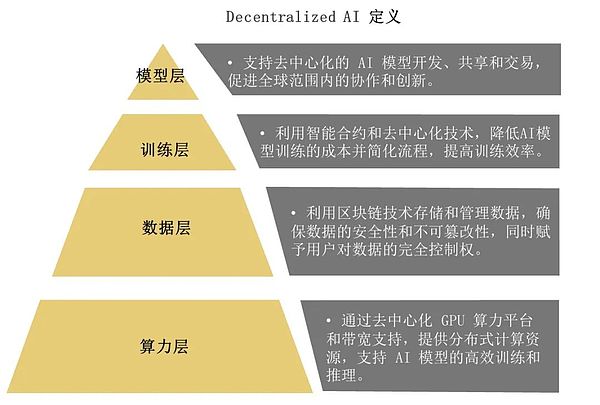Introduction
In the digital age, artificial intelligence (AI) has become a key force driving technological innovation and social progress. The development of AI is not only a technological advancement, but also an extension of human wisdom. AI has been the hottest topic in the venture capital industry and capital markets in the past period of time.
For this topic, we will share our research results in three articles. This article is the first one, which will take you through the history of AI, explore its core technical concepts, and look forward to the future of decentralized AI.
We also welcome entrepreneurs and project parties in this direction to contact us.
History of AI
Artificial Intelligence (AI) is a discipline that studies how to simulate, extend and expand human intelligence through computers and software. It is a study of intelligent agents that receive perceptions from the environment and perform actions.

The concept of artificial intelligence can be traced back to the Dartmouth Conference in 1956, which marked the official start of AI research. Since then, AI has gone through several important stages of development:
• Initial stage (1950s-1960s): Early research focused on symbolic AI, attempting to simulate human thinking through logic and symbol processing. AI research during this period was limited by computing power, but it laid the theoretical foundation for AI.
• Exploration and Application (1970s-1980s): The rise of expert systems, which encode human expert knowledge to solve problems in specific fields. AI during this period began to show its application potential in fields such as medicine and finance.
• The Revival of AI (1990s-2000s): The popularization of the Internet and the emergence of big data provided AI with rich data resources, which promoted the development of AI. AI technology during this period began to be applied to fields such as medical diagnosis and financial analysis, showing its wide application potential.
• The Era of Deep Learning (2010s-Present): The deep learning revolution, deep learning models represented by convolutional neural networks and recurrent neural networks have made breakthroughs in image recognition, speech recognition and other fields. AI technology during this period was widely used in commercial fields such as autonomous driving, smart assistants, and personalized recommendations, and achieved large-scale commercialization.
Core Technical Concepts of AI
The core technical concepts of AI cover multiple aspects from basic algorithms to complex system construction:

• Machine Learning: Training algorithms with data enables systems to learn and improve without explicit programming. Advances in machine learning algorithms, especially those such as support vector machines and decision trees, have significantly improved the performance of AI systems.
• Deep Learning: Large-scale machine learning methods based on neural networks, usually with a multi-layer network structure. For example, convolutional neural networks (CNNs) are used for image recognition, and recurrent neural networks (RNNs) and Transformers are used for natural language processing.
• Natural Language Processing (NLP): Technology that enables computers to understand, interpret, and generate human language. The development of NLP technologies, such as machine translation, sentiment analysis, and chatbots, has greatly improved the naturalness and efficiency of human-computer interaction.
• Computer Vision: Technology that enables computers to acquire, process, and understand visual information from images or videos. Advances in computer vision technologies, such as facial recognition, autonomous driving, and medical image analysis, provide technical support for the application of AI in security, transportation, and medical care.
What is decentralized AI

Decentralized AI represents the combination of AI and blockchain, and the training and use of AI models are achieved through distributed computing resources and data storage.
The rise of decentralized AI is mainly due to the widespread application of generative AI and the enthusiasm of the real world, and various projects have therefore accelerated into this field.
Synergy between AI and blockchain

AI and blockchain have many synergies. The combination of the two has brought new opportunities for the development of the industry, including but not limited to:
• Empowerment method:Improve contract decision-making, introduce economic models, and use tokens to motivate ecological participants to contribute. This combination not only improves the efficiency of AI models, but also promotes the healthy development of the ecosystem through economic incentive mechanisms.
• NFT market and DeFi market:Generate and identify in the NFT market, and monitor lending risks in the DeFi market. The application of AI technology improves the efficiency and security of these markets, and also provides new application scenarios for the development of AI technology.

The architecture of decentralized AI is mainly divided into four layers: model layer, training layer, data layer and computing power layer.
Model layer supports the development, sharing and trading of decentralized AI models; Training layer reduces the cost of AI model training through smart contracts; Data layer uses blockchain to store and manage data; Computing power layer provides distributed computing resources to support efficient training and reasoning of AI models.
Conclusion
The development of AI technology has not only promoted scientific and technological progress, but also brought revolutionary changes to the business field. With the continuous advancement of technology, AI is gradually penetrating into all aspects of our lives. Decentralized AI, which is a combination of blockchain and artificial intelligence, is also one of the current hot topics and has broad market prospects.
 JinseFinance
JinseFinance
 JinseFinance
JinseFinance JinseFinance
JinseFinance JinseFinance
JinseFinance JinseFinance
JinseFinance JinseFinance
JinseFinance Alex
Alex Kikyo
Kikyo JinseFinance
JinseFinance Cointelegraph
Cointelegraph Cointelegraph
Cointelegraph